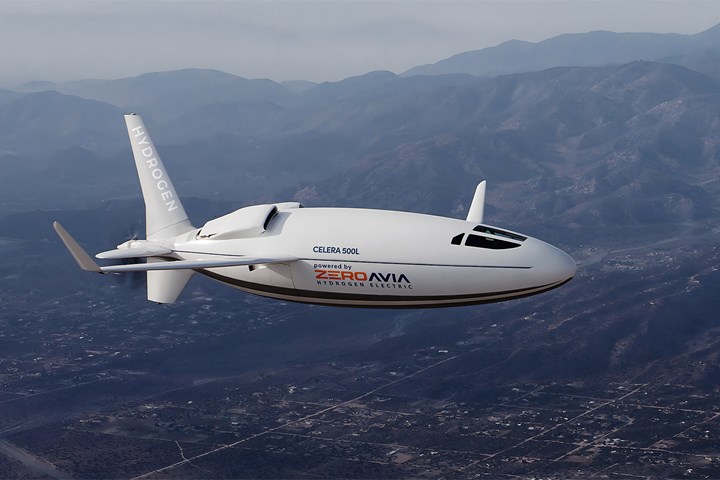ZeroAvia partners with Otto Aviation to deliver new airframe design with hydrogen-electric option
ZeroAvia will optimize the fuel cell-powered electric propulsion systems for Otto’s transcontinental Celera aircraft design, reducing maintenance costs while increasing range.
ZeroAvia (Hollister, Calif., U.S.) has announced a collaboration with Otto Aviation LLC (Yorba Linda, Calif., U.S.) to develop a hydrogen-electric powertrain to power Otto’s Celera aircraft, a new model of transcontinental aircraft that is scalable to 19 passengers. Hydrogen-electric engines use hydrogen in fuel cells to generate electricity, which is then used to power electric motors to turn the aircraft’s propellers, with the only byproduct being water.
Under the agreement, Otto and ZeroAvia will work to integrate ZeroAvia’s ZA600 zero-emission engines to Otto’s Celera aircraft. The collaboration is said to have the potential to make the Celera the first new airframe design to leverage zero-emission propulsion in its launch models.
“ZeroAvia’s hydrogen-electric powertrain helps us to realize the commitment Otto has made to lower operating costs and climate impact for operators” William Otto, CEO of Otto Aviation, says. “Otto is looking to provide the most efficient aircraft in all senses of the word: Minimizing maintenance and operating costs and reducing emissions.”
Otto’s aircraft design is said to offer exceptionally low drag across the entire aircraft. The design of its fuselage, empennage and wings take advantage of laminar flow. Laminar flow is the minimum drag solution for aircraft surfaces and features smooth layers of airflow with little to no mixing of adjacent layers. When coupled with fuel-efficient propulsion systems, like ZeroAvia’s powertrain, the Celera will reduce operating costs — as a result of reduced maintenance costs and falling hydrogen fuel prices — and increase range relative to comparable aircraft, while creating optimal passenger comfort and cargo capacity.
According to Otto Aviation, the Celera design is highly conducive to accommodate large volumes of hydrogen within the fuselage that will enable 1,000 nautical miles of zero-emissions range.
“The majority of our commercial deals to date have focused on retrofit and line-fit for existing airframes, which is essential to deliver zero-emission flight to market as quickly as possible,” Val Miftakhov, ZeroAvia, founder and CEO, notes. “However, efficiency gains from new airframe design can expand the impact of zero-emission aviation. We are pleased to collaborate with innovators, like Otto Aviation, bringing cutting-edge clean sheet designs to market as we can optimize the hydrogen-electric propulsion system for those designs.”
Related Content
-
Materials & Processes: Composites fibers and resins
Compared to legacy materials like steel, aluminum, iron and titanium, composites are still coming of age, and only just now are being better understood by design and manufacturing engineers. However, composites’ physical properties — combined with unbeatable light weight — make them undeniably attractive.
-
The state of recycled carbon fiber
As the need for carbon fiber rises, can recycling fill the gap?
-
PEEK vs. PEKK vs. PAEK and continuous compression molding
Suppliers of thermoplastics and carbon fiber chime in regarding PEEK vs. PEKK, and now PAEK, as well as in-situ consolidation — the supply chain for thermoplastic tape composites continues to evolve.

















